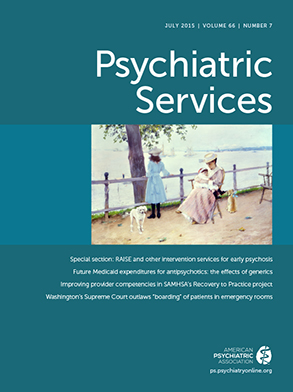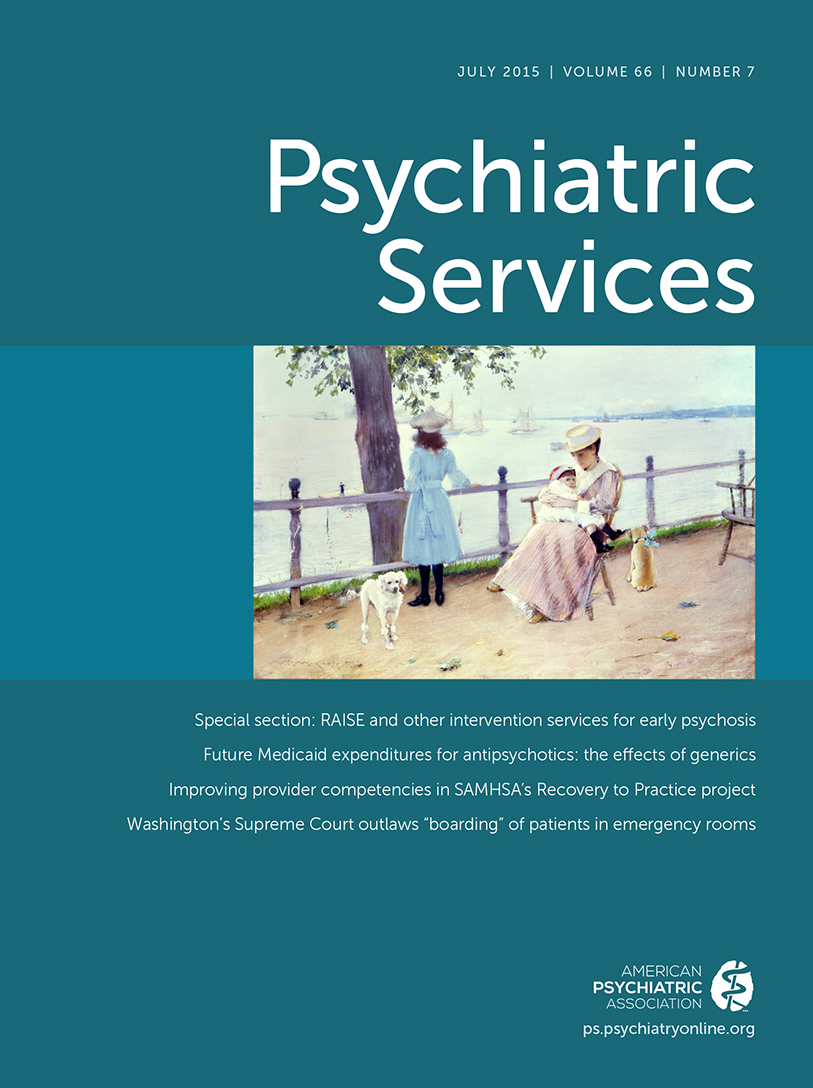The RAISE (Recovery After an Initial Schizophrenia Episode) Connection Program was a state-academic partnership that involved state mental health authorities (SMHAs) in Maryland and New York. SMHAs collaborated with researchers to implement a team-based approach, serving people with first-episode psychosis (FEP) (
1,
2). The National Institute of Mental Health (NIMH) provided funding to study FEP service implementation in two states. This column describes development of these partnerships, states’ interest in FEP services, and financing of Connection Program treatment teams.
Building on Historic Public-Academic Relationships
The RAISE Connection Program built on long-standing close partnerships between SMHAs and public-sector mental health services research programs at Columbia University and the University of Maryland. Descriptions of these partnerships have outlined the history of SMHA support for evaluation and policy analyses, use of public mental health settings for conduct of scholarly research, and products of those collaborations (
3–
6).
When designing the RAISE Connection Program, researchers worked closely with state partners to ensure that new FEP services would fit within existing systems of care. SMHAs, in turn, committed to funding costs of the clinical teams, at least during the research project, once federal funds were exhausted. Originally, this was a substantial commitment, because the initial randomized, controlled design involved four sites in each state, and federal funding could not support the entire service requirement. Eventually, because of federal funding reductions, the RAISE Connection Program was converted to an implementation study with one site per state, with federal funds covering teams’ initial costs. Each SMHA, however, committed to continuation funding for the FEP teams and, ultimately, went on to fund additional sites.
Beginning in 2008, investigators preparing the RAISE Connection Program proposal considered how FEP services might be delivered within public mental health service systems. Study planners assumed that most individuals eligible for FEP services would not have Medicaid or other insurance that covered FEP services not found in routine benefit packages (for example, supported education and employment services). Therefore, the emphasis was on using categorical public mental health funding rather than relying on Medicaid or other insurance. The planning occurred before passage of the Affordable Care Act (ACA), which expanded Medicaid in both states for single adults who were not already disabled. The ACA allowed us to change some assumptions about how best to finance services, because it made health insurance, including behavioral health benefits, available to many individuals who would seek FEP services.
Why are States Interested in FEP Services?
A confluence of factors has increased interest in FEP services. Changes in health care financing stimulated by the ACA increased awareness about problems associated with episodic fee-for-service treatment of long-term disorders. Reports of the effectiveness of routinely available FEP services in many European countries, Canada, and Australia supported a public health approach fostering early recognition and referral to specialized services (
1). Well-publicized instances of violence by young adults, however inappropriately associated with FEP, have heightened public awareness of the paucity of readily available, youth-friendly mental health services. NIMH’s RAISE initiative focused attention on the negative consequences of long durations of untreated psychosis. Schizophrenia affects individuals across socioeconomic strata and is thus well suited to an insurance pool in which all members of a population participate at shared expense. The promise that specialized FEP services would reduce costs to states and the federal government (direct health care expenses and disability payments) provides a fiscal incentive to promote FEP services (
1).
Basic Assumptions about Implementing FEP Services
The goal of the project was to assess the implementation of the RAISE Connection Program in environments where clients’ needs—rather than what insurance would cover—drove service decisions. The project set expectations for FEP service team size (25 clients) and staffing (full-time team leader and supported employment–education specialist, .5 full-time equivalent (FTE) recovery coach, and .2 FTE psychiatrist), and teams were charged with providing high-fidelity implementations of the intervention within those constraints (
7). The study investigated which participants received how much of what services, and the service design minimized fiscal incentives to over- or underserve. This “all comers” strategy allowed estimation of the impact of the availability of such services on a population basis independent of selection effects due to ability to pay or availability of particular types of insurance.
The investigators and their public-sector service partners made several assumptions about how to implement and finance the intervention. First, FEP services should meet the needs of a defined geographic area and its population. Anyone in the area meeting the eligibility criteria would be offered services, regardless of insurance status. Second, a dedicated team would provide FEP services; thus teams would be placed in population centers large enough to support a team (
8). Third, the team would not be responsible for filling its own caseload; separate outreach and referral staff were responsible for outreach and eligibility determination. This is consistent with a real-world model that requires teams to take all eligible individuals referred as long as the team has an opening.
Fourth, in addition to funding for recurring costs, sites would need funding for significant start-up costs associated with FEP service implementation (for example, acquiring and furnishing space, training the team, and staffing a team fully while it was still reaching a full caseload). Fifth, services delivered by the team would include traditional, medically oriented psychiatric services; support services, such as supported employment and education; and clinical case management—all carried out in a context of shared decision making to enhance engagement and, presumably, outcomes. Sixth, clinical staff would meet weekly as a team, separate from meetings with service recipients and family members, even though such meetings would not be billable in routine practice. Seventh, teams would be embedded in existing mental health programs; RAISE Connection Program and local agency leadership would share responsibility for supervision and regulatory oversight, with the assumption that local agencies would assume full responsibility at the conclusion of the study. Site selection was a joint effort between project investigators and state leadership.
The eighth assumption was that, ultimately, Medicaid might be a financing mechanism for many of these services. We anticipated that some potential participants would be covered by Medicaid—on the basis of income and age, through Temporary Assistance for Needy Families, or via some other state Medicaid option for poor or medically indigent individuals—and that few, if any, would have Medicaid by virtue of qualifying for Supplemental Security Income (SSI) benefits due to disability because individuals who received SSI because of a mental impairment would be unlikely to qualify for an FEP program. By virtue of their meeting SSI’s disability criterion, the duration of their illness would have been at least 12 months, by which time they would have been ill for too long to meet the duration criterion for eligibility for FEP services (within a year of emergence of psychotic symptoms).
The SMHAs recognized that a potential benefit of investing in FEP programs is that such programs might forestall the disability so often associated with schizophrenia and, therefore, could help individuals stay in school and employed as opposed to requiring life-long state-funded services. The RAISE initiative and the SMHAs’ goals of reducing psychiatric disabilities were, therefore, well aligned. The partnership involved training, support for implementing evidence-based practices, and evaluation and research activities related to delivering behavioral health services. The collaborative work between the SMHAs and their academic partners also meant that a natural infrastructure was available to train staff, implement the new services, monitor implementation fidelity, and conduct required assessments.
Start-up and Expansion to Additional Sites
Limited public resources in behavioral health characterized the period for planning and implementing the RAISE Connection Program. Indeed, the funding for RAISE came from the federal government’s stimulus plan in response to a recession. Despite this climate, leadership in both states recognized the importance of FEP services and embraced the opportunity. Each state committed to paying the staffing costs (approximately $250,000 per team), costs of psychotropic medications for participants without insurance coverage for the prescribed medications, and modest flexible funding (approximately $10,000 per team per year) for transportation and other items to facilitate treatment engagement. In addition, each state provided space and the overhead services associated with clinical space (such as security and housekeeping).
Both Maryland and New York State have opted to launch additional FEP teams modeled on the RAISE Connection Program. State leadership saw that the research had established the feasibility of such teams in routine practice settings and the success of teams in engaging and retaining consumers. Further, participation in the program was associated with positive outcomes, including enhancement of participation in school and work and reduction of clinical symptoms. New York State’s budget for the Office of Mental Health now includes $2.5 million annually to facilitate the implementation of FEP programs as part of an initiative called OnTrackNY that is a direct outgrowth of the RAISE Connection Program. The initiative in New York (
practiceinnovations.org/CPIInitiatives/OnTrackNY/tabid/202/Default.aspx) is live in four sites, with plans to expand to an additional ten sites in the coming year. In fiscal year (FY) 2014, Maryland launched the Early Intervention Program, which combines funding for community outreach, a range of services, and research on various aspects of early intervention in psychotic disorders. In FY 2015, the Early Intervention Program plans to train and implement two FEP service teams modeled on the RAISE Connection teams and to continue the original RAISE Connection team site.
Financing FEP Services
Because of the expense so often associated with people who have been disabled by schizophrenia, states may be motivated to implement FEP services to forestall disability and maximize recovery. An increase in FEP services means an increased need to train providers to deliver these services, to measure performance to ensure availability of such services, and to finance training and performance monitoring. For a fuller discussion of monitoring implementation fidelity and FEP financing strategies, including an innovative financing model to align payment incentives with best practices, see the column by Essock and colleagues (
7) and the Economic Grand Rounds column by Frank and colleagues (
9). In addition, Goldman and colleagues (
10) reviewed financing approaches taken in various U.S. settings in a column published in 2013.
Conclusions
The RAISE Connection Program in New York and Maryland benefited from close working relationships between the SMHAs and university investigators. The basic financing plan used state mental health dollars and a public health approach to fund a team to deliver FEP services to individuals with early psychosis regardless of insurance status in an effort to maximize recovery and forestall disability that would result in increased disability payments by the states. Media reports in the United States have heightened public awareness of the need for appropriate treatment for youths with mental health problems, and the RAISE Connection Program has demonstrated how such treatment can be implemented and sustained.
Acknowledgments
This work was supported in part with federal funds from the American Recovery and Reinvestment Act of 2009 and the National Institute of Mental Health under contract HHSN271200900020C, by the New York State Office of Mental Health, and by the Maryland Mental Hygiene Administration, Department of Health and Mental Hygiene.
As part of the RAISE Connection Program, Dr. Essock, Dr. Goldman, and Dr. Dixon may be part of training and consultation efforts to help others provide the type of FEP services described here. They do not expect to receive compensation for this training other than that received as part of work done for their employers. The other authors report no financial relationships with commercial interests.

